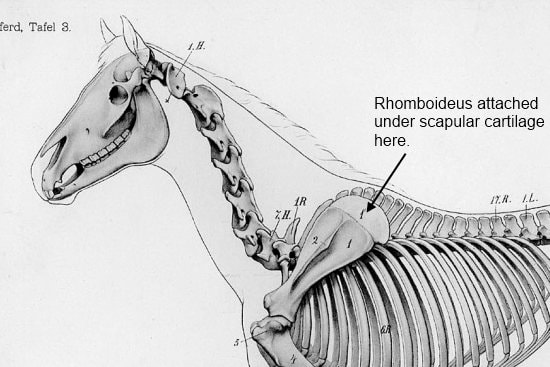|
Okay this week lets look at the rhomboideus muscle. It's a bit of a read for this week, but I think it's worth it in the end.
L O C A T I O N: The rhomboideus muscle is a deeper muscle, lying underneath the trapezius muscle. It also has two parts to it. The cervical (neck) part comes off the nuchal ligament. It starts as far up the neck as C2 and goes all the way down to T2. The thoracic part runs from T2 to T7 and attaches to the dorsal spinous processes via the enlarged section of the supraspinous ligament that overlies them at that section of the spine. It inserts on the underside of the scapular cartilage (that piece of cartilage that comes off the top of the scapula). R O L E: The cervical part can pull the top of the scapula forward, and both will pull the scapula up and also pull it in towards the body. Also, when the leg is weight bearing and therefore immobile, this muscle will also act to lift the neck. D Y S F U N C T I O N: Saddle Fit: There is a theory that I've heard and it makes a lot of sense to me. The scapula slides under the front bar tips as it rotates back when it is unweighted. (That is, if the front bar tips have enough relief built in to allow this to happen). Well, what would happen if there isn't enough relief there and the shoulder blades have too much contact with the front bar tip, or if the saddle was held too far forward so it was sitting on the shoulder blades? Wouldn't it make sense that the horse would try to pull his shoulder blade in closer to the body? You see the scapula isn't supposed to be vertical. It follows the rib cage and is tilted with the top closer to the midline of the horse. Since the rhomboideus attaches underneath the scapular cartilage, contracting it will act to pull the shoulder blade in. So if there are problems with the shoulder blade hitting the front of the saddle, the rhomboideus would be one of the muscles the horse uses to avoid the discomfort or pain. What happens when you use a muscle a lot? It gets bigger! What would happen if you increase the size of the rhomboideus underneath the scapular cartilage? It would shove the scapula out to be more vertical since it would take up more room between it and the spine. Use of Tie Downs: Since the cervical rhomboid acts to elevate the neck when the leg is weighted, it is one the horse uses a lot if it is trying to lift its head against the constraints of a tie down. So a lot of arena rope horses that are consistently used in a tie down will have a very enlarged cervical rhomboideus - an extra thick roll of muscle at the top of the neck - but some of the other neck muscles won't be well developed. R E S T O R I N G M U S C L E S Y M M E T R Y: If you notice an imbalance of this muscle, the first place that I would check would be your saddle fit. As the theory above states, ill fitted saddles can cause a lot of improper hypertrophied (enlarged) development. There are many saddle fitters in the Middle Tennessee area that can be of great help if you need them! If saddle fit is the problem, correcting how your saddle fits on your horse and bodywork is where to start. But, it will take time for the muscle to go back to a symmetrical look/size once the problem is resolved with the saddles. I hope I didn't bore anyone this week, and I'm happy to answer any questions that I didn't clear up with this week's post. Hope you all have a great week and give your pony a treat just from me!
0 Comments
Leave a Reply. |
Muscle Monday Posts!I'll post all of the Muscle Monday posts from our Facebook and Instagram here so it's a little easier for you to find if you'd like to learn more about your horse's muscles. Archives
October 2021
Categories |
"The real joy in life comes from finding your true purpose and aligning it with what you do every single day." |
"I’ve often said there is nothing better for the inside of the man, than the outside of the horse." |
Copyright 2021
Proudly powered by Weebly


 RSS Feed
RSS Feed
